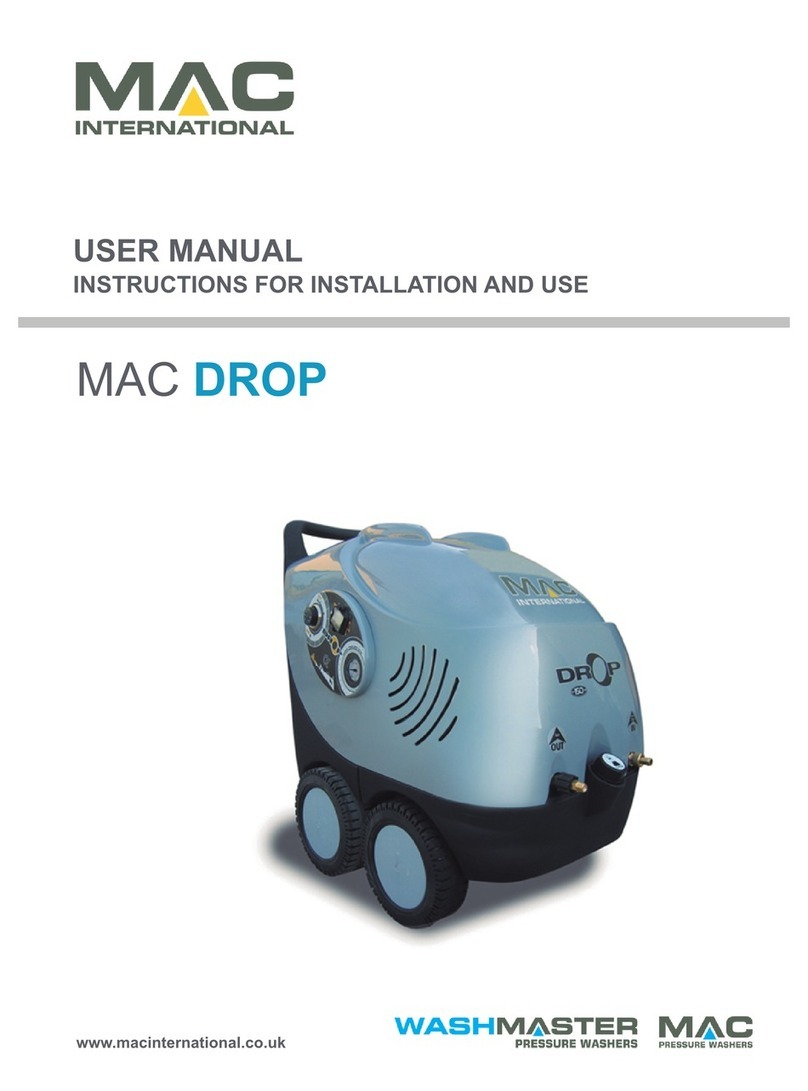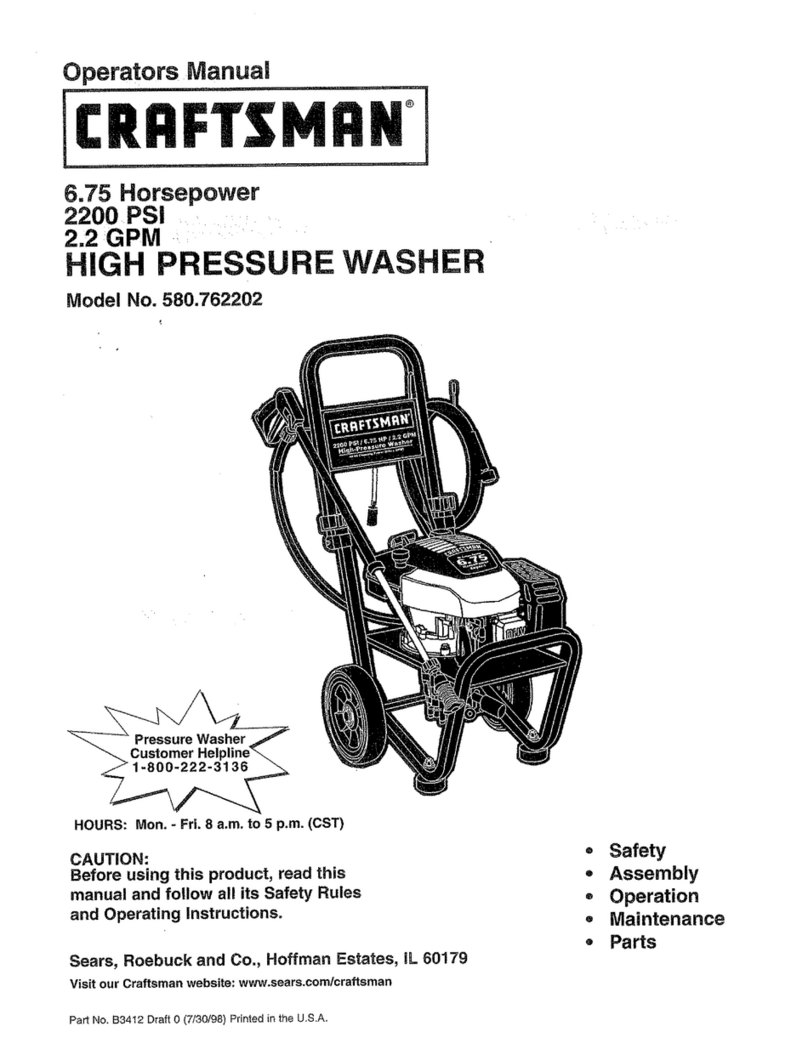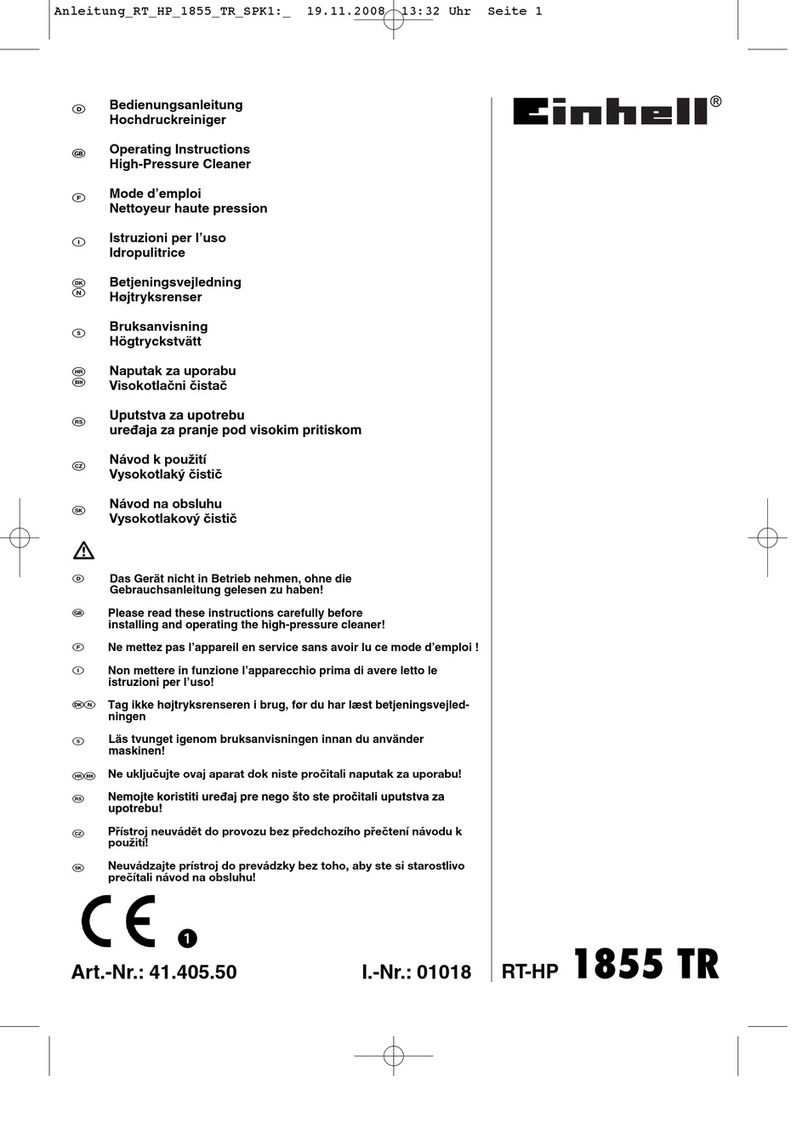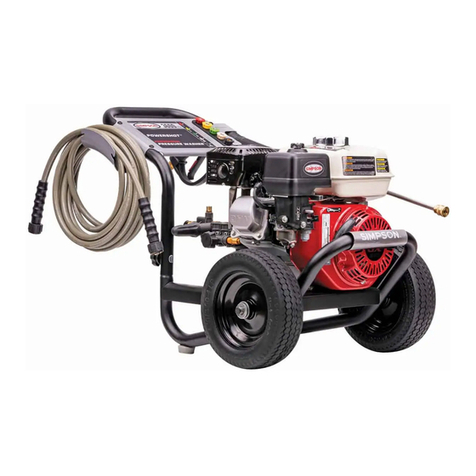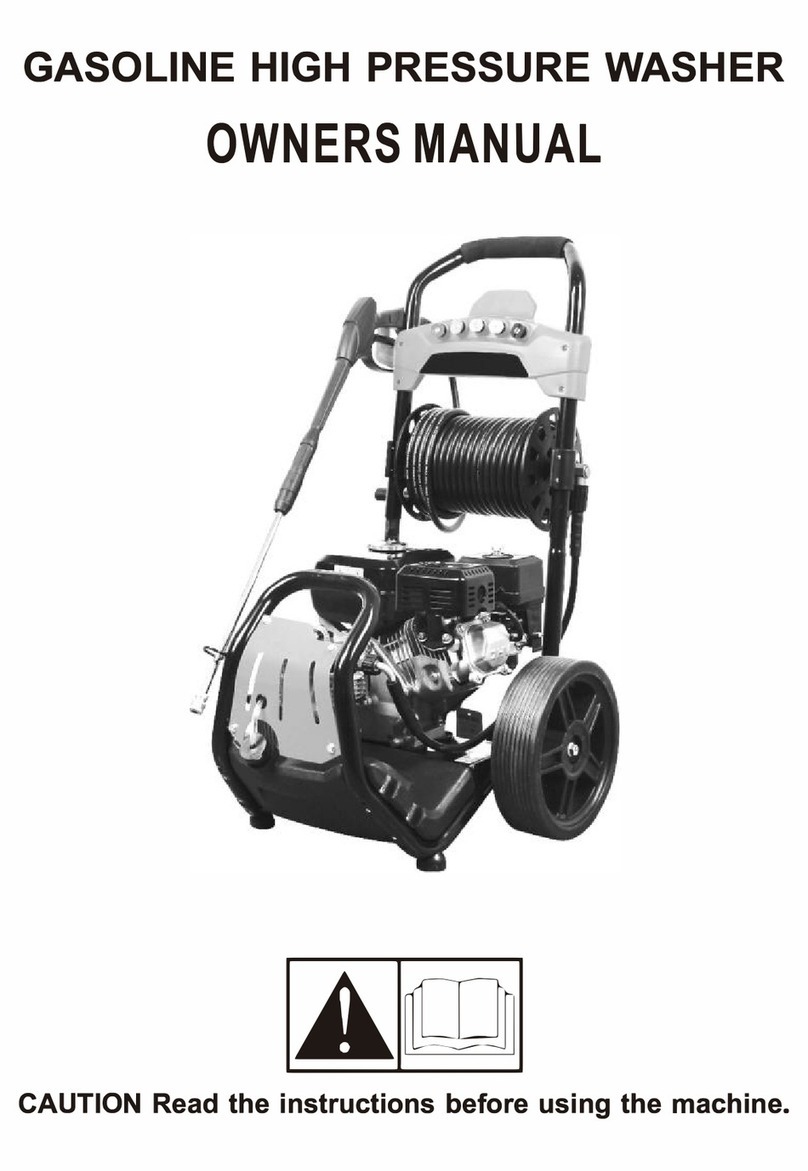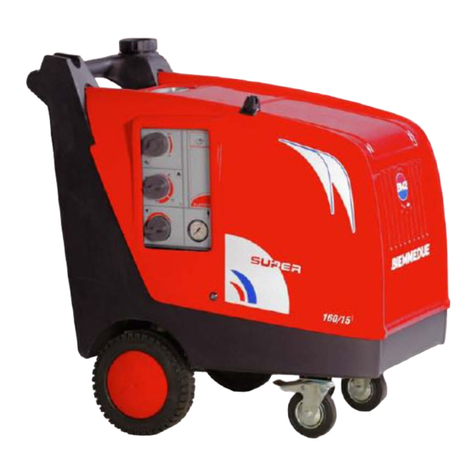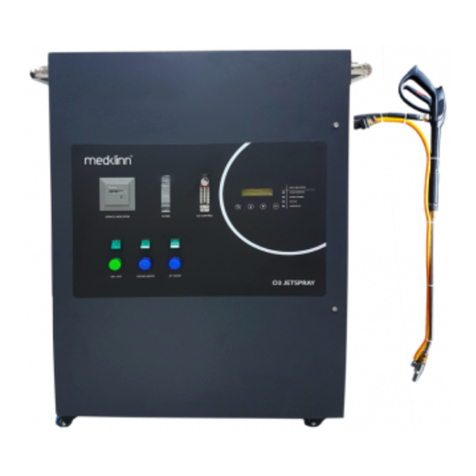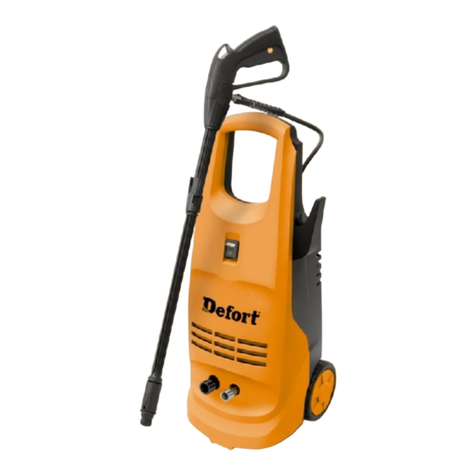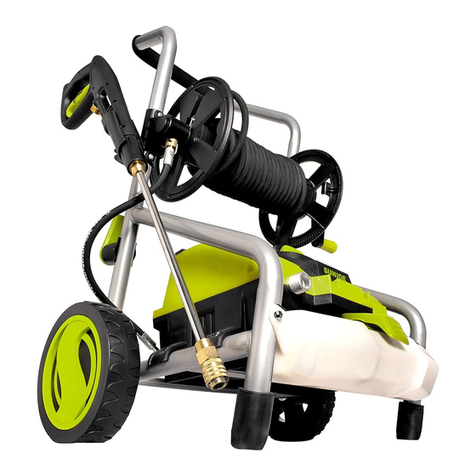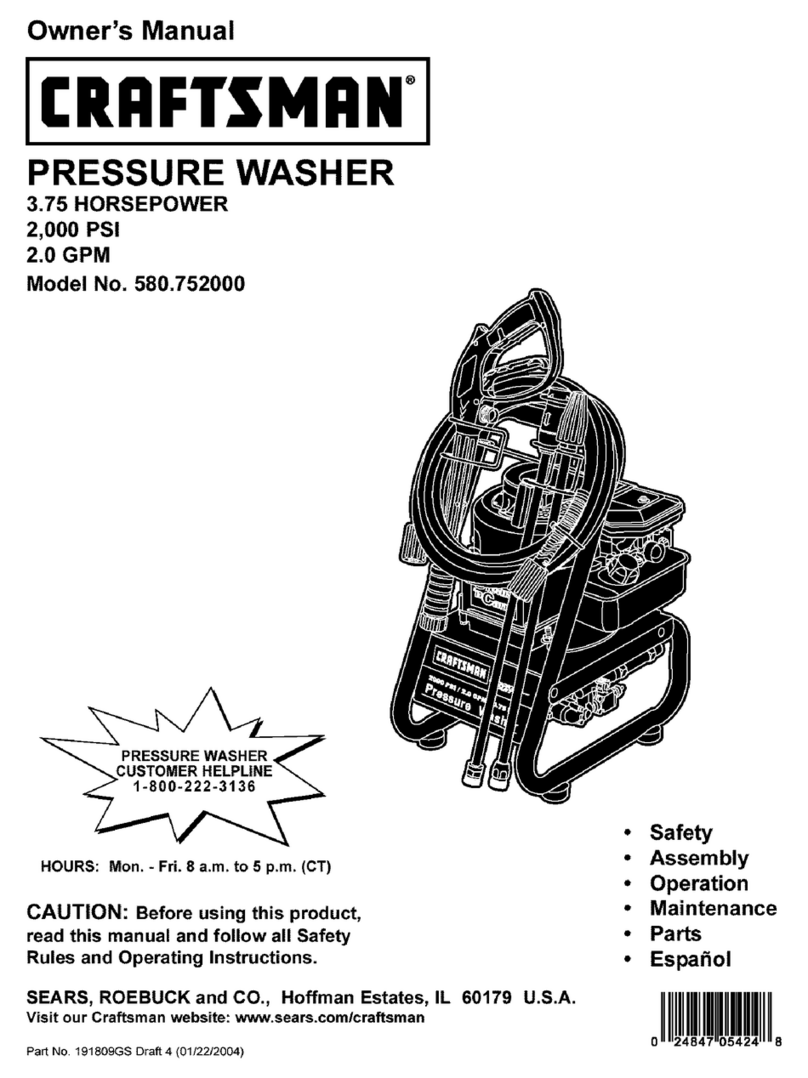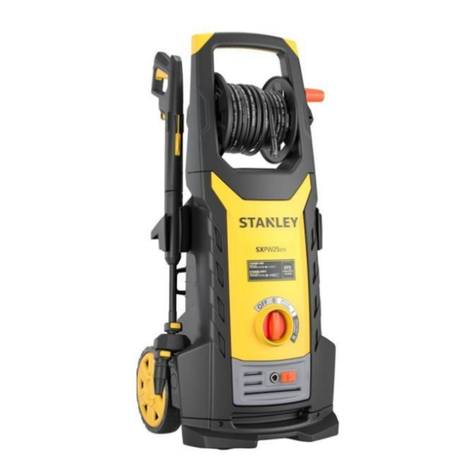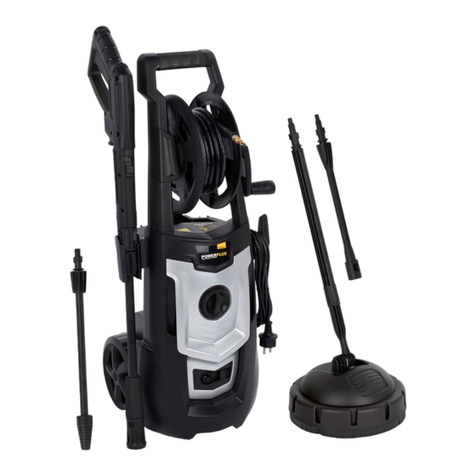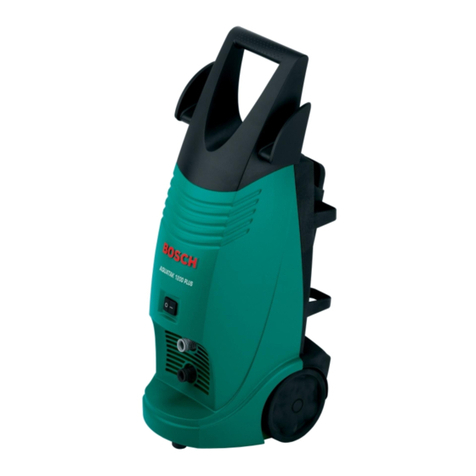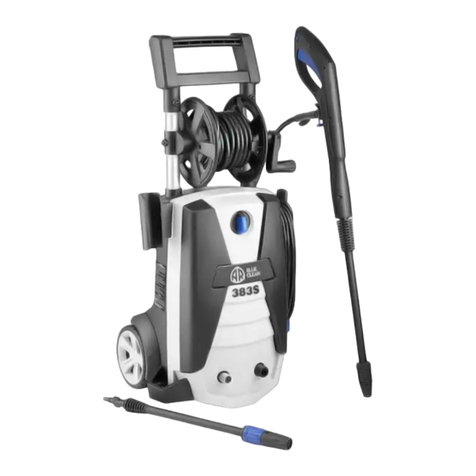MAC DROP REVOLUTION User manual

ENGLISH LANGUAGE
INSTRUCTIONS MANUAL
INSTRUCTION FOR INSTALLATION AND USE
Congratulations!
By purchasing a MAC high pressure cleaner, you have purchased a high technology machine that will allow
you to realize, for a long time, washing operations with care, versatility and safety.
The customer and buyer must verify that the operators have read and know the content of the manual and
that, therefore, attentively and meticulously follow all the indications.
The manufacturer doesn't respond of the damages caused to things, people or animals or those suffered by
the high pressure cleaner itself, if the conditions here clarified are not respected.
This manual is an integral part of the machine and must therefore preserved with care for all the life of the
high pressure cleaner, up to its demolition.
The manufacturer reserves himself the right to the change, also without warning, of his/her own products,
without varying, in the case in which the changes are marginal, the documents and the relative technical
documentation.
1. Field of employment
1.1. The high pressure cleaner is exclusively destinated to the washing, by a jet of high pressure hot
water, of objects and surfaces available to substain its mechanical and thermal action, and,
eventually, the chemical action of the additive liquids, detergents and disinfectants, etc...; it
allows therefore the cleaning, the detersion, the disinfection, the sandblasting, the descaling,
etc…using accessories, of objects and of surfaces.
1.2. The destination of employment of the high pressure cleaner must meticulously been respected,
and every other employment must be considered improper.
1.3. The nameplate of identification (with the technical characteristics of the machine) is positioned
on the cart and it is always present. Please make sure, when you purchase the high pressure
cleaner, that the machine has this nameplate of identification. Otherwise, advise immediately
the supplier. Machines without nameplate of identification have to be considered anonymous
and potentially dangerous; they mustn’t be used, otherwise every responsibility of the
manufacturer will decade.
2. The characteristics of the personnel employed to use the high pressure cleaner
2.1. All those people that deal with the operation of the machine must dispose of a specific
education or of an experience matured on high pressure cleaners.
2.2. To prevent damages to things, people or animals, we recommend to the clients to inform all the
operators about the possible consequential risks caused by the installation and the use of the
high pressure cleaner.
2.3. The operator of the machine has to use always the described means of personal protection,
according to the law of the country of destination and what is given to him/her by his/her
employer (safety shoes, work overalls, protective glasses, etc...).
2.4. The personnel employed to the installation, to the use or to the maintenance of the high
pressure cleaner must be adult, experienced, mature and aware of his/her own suitable

2.5. assignments and must be able to correctly interpret what described in this manual,
guaranteeing correctness, safety, as well as scrupulousness in the controls.
2.6. Possible consequential responsibilities from the employed, and authorized personnel, to the
installation or to the use of the machine are delegated to the customer buyer.
2.7. Those people that deal with the maintenance must dispose of knowledge and specific
(maintenance technician) competences that allow him to correctly interpret instructions and
sketches.
3. Accident prevention
3.1. The instructions furnished in this manual don't replace in any way the norms related to the
safety, to the installation and the use, to the technical data or the norms in force in the nation of
installation or use or the norms dictated of the common sense.
3.2. Technicians or maintenance technicians are obliged to notify any possible defects or
deteriorations that are able, in any way, to compromise the original safety of the plant.
3.3. The serial high pressure cleaner is not equipped for working in environments characterized by
particular conditions of inflammability or explosiveness; flameproof equipment is supplied only
and exclusively on specific request. It is forbidden to install the high pressure cleaner in
environments where inflammable materials are present or with particles it suspended in the air:
acids, inks, varnishes, resins, solvents, plastic subjects, etc.; follow the norms imposed by the
fire department.
3.4. During the filling of the fuel tank, the high pressure cleaner must be disconnected from the
electric net. At the same time it is absolutely forbidden to smoke or approaching the machine
with free flames during the filling of the fuel tank.
3.5. The hot water high pressure cleaners are projected for an economic combustion, clean and
respectful towards the environment and deprived of the residual exhaust gases. Despite this,
inhaling high quantity or percentages of gases, such CO, is harmful and lethal particularly.
3.6. If the high pressure cleaner is installed or used in places and closed (like garages or
establishments) environments, it is necessary to predispose a device of evacuation of the gases
together with a recycling of the air supply and for the restoration of the air in the place or in the
closed environment.
3.7. Never obstruct the terminal of the chimney; with objects, lance or gun, in proximity of the outlet
of the smokes. It’s also considered highly dangerous, both for the smokes and also for the
elevated temperatures reached. To avoid possible burns, inform technicians and operators
about it.
3.8. The high pressure cleaner and its plant as the place and the environment, are forcedly exposed
to the water and the damp that injure the natural conditions of isolation of the plant. Don't use
therefore unsafe electric cables, thorns or plugs, and sockets; to check the integrity and the
isolation of the electric cable, together with the equipment of the operators. Don't absolutely
touch the thorn or the plugs with wet hands or feet. To avoid accidental switching on, turn the
interrupter on OFF before inserting or disconnecting the power supply. Don't pull the high
pressure cleaner using the electrical or to extract its thorn from the socket.
3.9. Use with extreme care the chemical detergents not to deteriorate the environment (degradability
90%), parts or components of the machine, according to the updating of the legislative decree.
Besides, always check the degradability and the aggressiveness of the used detergents. Never
use acids, inks, solvents, liquid oily, varnishes, resins, etc…
3.10. The "cold" starting of the high pressure cleaner can cause some serious damages to the pump
and the circuits; the standstill prolonged at temperatures under 0°C could cause breakups and
damages to the pump and the pipes; therefore the emptying of the machine is advisable.
3.11. Always protect the high pressure cleaner from the atmospheric agents, from the cold and from
the frost.
3.12. Never direct the jet of water towards people (not even to clean their clothes or their shoes) or
animals, nor the machine itself or any objects under electrical tension.
3.13. Lance and gun, although equipped with proper hilts, they have a modest counterblow to the
departure of the jet; to maintain them with strength with both the hands. Do never touch the jet
of water during the operation of the idropulitrice.
3.14. If some defects, damages or deteriorations on the machine are found, disconnect it
immediately, and call an assistance authorized center assistance authorized or to the supplier.
3.15. Don't leave never, without overseeing, the high pressure cleaner working in presence of
children.

3.16. ATTENTION: if used in the correct way and it is in a good state, the high pressure cleaner sends
forth a sonorous level of pressure (noisiness) less than 90 Dbas, for which necessary particular
protections are not made for the operators.
4. Characteristics of the high pressure cleaners
The high pressure cleaners DROP are divided in the following models:
Model
Max.pressure
(bar-psi)
Max. flow
(l/min-gal/min)
Installed Power
(KW)
Voltage
50Hz (V)
Weight
(Kg-lb)
Water temp.
(°C-°F)
120/11
120-1740
11-3
2.8
230
100-220
30-100/85-212
130/10
130-1885
10-2.6
2.8
230
100-220
30-100/85-212
160/15
160-2321
15-4
4.5
400
120-264
30-100/85-212
200/15
200-2900
15-4
5.8
400
120-264
30-100/85-212
5. Instruments of the high pressure cleaner
Q1: Main Switch
K1: Thermostat with switch
MA: Pressure gauge
SD: Detergent tank cap
IN: Connection to the water supply (inlet)
OUT: Connection to the lance (outlet)
6. Transport and unpacking
6.1. Submit lifting and transport to
specialized personnel. To protect the
machine, especially during the
transport on road, from bumps, damps
or from vibrations, etc…; the high
pressure cleaners are climbed on
wheels and therefore they must firmly
be anchored before the beginning of
the transport. To underline the
dangerousness in the moving of the
suspended loads, operators must be
warned about risks to collisions.
6.2. To unpack the high pressure cleaner,
verify the one is not damaged and has
got all the parts and components. In
the case in which the machine is
damaged, please call the supplier and
do not use the machine. We remember

that the elements used in the high pressure packing could to hurt the operator if not handled
with care. These packings must be digested therefore and not left to the course of children or of
irresponsible persons. The same is worth for the objects used in the removal of the unpacking
pack (knives, scissors.). For tied up demands to unpacking and to the transport, some
components are supplied not installed; proceed therefore to the installation according to the
instructions of the manual.
7. Installation
7.1. Control carefully that the environment for the installation of the high pressure cleaner
considering all the foreseen and unforeseen possibilities. The machine is equipped with insane
wheels, therefore it is unadvisable to position, without precautions, on tilted surfaces. Do never
tilt the high pressure cleaner to more than 20° when the tanks are full.
8. Connection to the electricity supply
8.1. The high pressure cleaner can be connected to alternating single phase (230V) or three phase
(400 V) with frequency 50hz. For the three phase models, the high pressure cleaner is normally
supplied connected to 400 V, although can be in demand connected to other connections (for
instance 230v).
8.2. For the maximum absorption of the electricity, compare the underlying chart.
8.3. Verify that the electric net, to which the machine is connected with the electric cable, has the
appropriate characteristics.
8.4. The high pressure cleaner is endowed with a magnetothermic switch that interrupts the power
supply in the case the absorption of the supply overcomes the value of the setting; for the
location of the switch, take a look to the electric plan attached to the machine.
8.5. The client buyer is kept to subsequently protect the line of the power supply by installing a
lifesaver with a load not exceeding 30A.
8.6. The cable is supplied without plug for the connection to the net: this must be installed by the
buyer, which will verify that:
8.1.1. The plug is proper for the data of the voltage and the tension above described;
8.1.2. The plug is conforming to the norms in force in the nation of installation and use and that
in any event it is earthed.
8.1.3. The connection cable and plug connection is waterproof.
8.1.4. If a cable with extension is used, this must have a minimum section of 2,5 mmqs if the
cable is long up to 20 mt, or of 4,0 mmqs if the cable has a superior length than 20 mt.
The flying thorns and plugs are forbidden: to use some cablereels.
8.1.5. If the cable of the connection is damaged, this must be immediately replaced with a
proper cable: such operation must be performed by specific and authorized personnel.
KW
Motor absorption A
Thermic 230v A
Thermic 400v A
KW 2,2
13
14
0
KW 3
8
14
9
KW 4
10
16
11
KW 5,5
13
22
14
KW 7,5
15,6
28
20

9. Connection to the water supply
9.1. The pressure of the water supply must be at least 2 bar. If the pressure is insufficient, the pump
will inhale air and will be subject to overheating and vibrations with serious damages to the
pump and the car.
9.2. The water supply must provide a flow of water of at least of the 10% of the course of the high
pressure cleaner (compare the chart with technical characteristics).
9.3. First of all, connect the water supply tap to the machine input pipefitting IN, using a hose with
proper diameter, whether to connect the lance to the link of exit OUT.
9.4. For a long duration of the pump, and to avoid the use of water containing sand or other particles
that jeopardize the efficiency of the valves and of the pistons or of the gaskets. To such purpose
it is advisable to apply a filter to the pipe of suction to great surface and low loss of load,
handling periodic substitution.
9.5. When the machine is equipped with a special tank, it is convenient to install a filter upstream of
the tank: the pipe of water feeding must have a diameter not smaller than the link of the
connection to the machine and must be prepared in such way to avoid that possible airlocks are
formed.
9.6. The water supply can have a maximum temperature of 60°C and a maximum pressure equal to
8 bar. The gaskets and other parts and components of the pump could be irremediably
damaged when the machine is made to work without of water, even if for short periods. Verify
that the tap of the water supply is completely open before the high pressure cleaner is switched
on.
OPERATION
10. Switching on
10.1. To bring the interrupter in position 1 and to maintain the thermostat to the least (rotated
counterclockwise in sense) one.
10.2. To act on the trigger of the gun (hilt) on the lance, maintaining her/it with strength to
compensate its counterblow and making to work the car for 2 or 3 minutes: this allows to bait
the pomp and to eliminate possible residues that could clog the nozzle; The trigger of the gun
has a sure that prevents the accidental activation of the throw. To insert the sure one when the
lance is not used. In this condition the car works to cold water.
10.3. In the case in which a detergent is used, to insert him/it in the reservoir on purpose predisposed
to the purpose and to open the faucet.
10.4. For the water operation warm, to rotate the thermostat to regulate its temperature.
10.5. To press the interrupter.
11. Switching off
11.1. By releasing the trigger of the gun, the jet of water interrupts and the machine stops, remaining
however turned on and available to the use: to stop therefore the safety catch on the trigger.
11.2. To switch definitely off the machine, turn the switch on O; if the machine has worked with hot
water it is opportune, before switching off the switch, to lower the temperature, that is to rotate
on 0 (in sense counterclockwise) the thermostat and letting work the high pressure cleaner with
cold water for about 2 minutes, to cool the coil.
11.3. For prolonged stand-by, before turning off the machine, it’s necessary to cool the coil as
previously clarified: close therefore the tap of the water supply, operating on the trigger, so that
to unload completely the water from the circuit. This procedure is advisable especially in places
with temperatures go under zero.
11.4. As soon as the water flow stops, switch the machine off by acting on the switch.
11.5. ATTENTION: the operation of the pump in absence of water could irreparably damage the seals
of the pomp.

12. Maintenance
12.1. It is absolutely forbidden to effect controls or operations of maintenance with the machine
operating or under tension: always remove the electricity supply!!! Don't even effect reparations
of fortune or precarious, and never use non-original spare parts.
12.2. The operations of extraordinary maintenance and the control of the combustion must regularly
been realized by specialized personnel.
13. Pump
13.1. The pump is equipped with three pistons in ceramics with automatic recovery of possible
leakages.
13.2. If a persistent dripping is noticed under the body of the pump, replace the piston waterproofing
seals. Nevertheless, in the first hours of exercise, a small loss points out only and exclusively an
arrangement of the seals and not a breakdown.
13.3. If there are some losses of oil between the body of the pump and the head of the pump, it is
necessary to remove the oil, to get off the head and to handle the substitution of the seals of
the head. For this operation it is necessary to contact a specialized and authorized assistance
center.
13.4. Restarting the pump after the maintenance to verify that this is supplied of oil. The oil must be
replaced after the first 50 hours of operation and subsequently every 200 hours of operation;
the ability of the reservoir of the oil is equal to 0,55 liters. Use only and exclusively oil with brand
Esso Plus Motor Oil 20W30 or Shell Oil X100 20W40.

Boiler exploded view
1) Transformer
2) Plug
3) Fitting
4) Nozzle support
5) Cable
6) Fitting
7) Seger
8) Glass
9) Seal
10) Shell
11) Fuel nozzle
12) Nut
13) Cover
14) Electrode
15) Screw
16) Plate
17) Deflector
18) Funnel air
19) Band
20) Ring
21) Coil
22) Hose
23) Filter
24) Hose
25) Nipple
26) Solenoid valve
27) Nipple
28) Copper pipe
29) Motor burner
30) Coupling
31) Fuel pump
32) Refractory
33) Band
34) Internal coil
35) Fan
36) Air conveyor
37) Net
38) Air regulator
39) Nut
40) External coil
14. Boiler

14.1. To improve the power of the boiler, is absolutely necessary to clean the coil. Effect this operation
in the following way:
14.1.1.Get off the group boiler burner from the machine and to separate the boiler from the
burner.
14.1.2.Remove the cover of the boiler.
14.1.3.Remove the band of the boiler freeing the serpentine one.
14.1.4.Use a rigid brush to eliminate the soot from the serpentine and an aspirator for the dust.
14.1.5.Reassemble the band, the cover and the burner again installing the group boiler burner
on the machine.
15. Electrodes
15.1. Periodically check the position of the electrodes so that to guarantee the best combustion and
to avoid the formation of the soot.
16. Fuel filter
16.1. To avoid the seizure or the breakup of the pump, because of the impurities in the fuel, the
circuit of the fuel is equipped with a filter, that must periodically be gotten off, and cleaned with
a jet of compressed air. The substitution of the filter is advisable when an effective cleaning
becomes impossible.
17. Water filter
17.1. Monthly check the filter of the water, both that predisposed on the machine and the possible
one installed by the consumer on the line of supply.
18. Demolition
18.1. To allow the recycling of the raw materials, it is to separate well: pack (if supplied), the
exhausted oils and the lubricants, the electric motors, metallic pieces, parts and components in
plastics.
18.2. It is compulsory to respect the norms in force related to the production, detention, harvest and
disposal of the refusals, according to what established by the legislative decree 22/97. The
exhausted oils must be delivered to the National Consortium Obligatory, while possible packings
must be digested according to what established by the title II of the legislative decree 22/97.
18.3. ATTENTION: Maer Idropulitrici society does not assume any responsibility for damages to things,

personal or animals, consequential and consequent to the re-use of the single parts or the
single components of the machine for function or situation of the assemblage different and
different from those original for which the high pressure cleaner has been conceived. Finally,
when demolished, it is to destroy well the nameplate of identification together to every other
document related to the same car.
19. Problems during the operation
Problem
Cause
Solution
The inlet hoses vibrate
1. There’s a foreign piece in a
valve.
2. There’s air suction.
1. Disassemble the valve and
remove the foreign piece.
2. Identify the source of the air
suction and eliminate it.
The burner doesn’t switch on
1. The thermostat is not
engaged or too low
regulated.
2. The fuel is missing.
3. The electrodes are dirty of
badly positioned.
4. The electrode supply cables
are earthed or burned.
5. The fuel filter is blocked.
1. Insert or adjust the
thermostat.
2. Put fuel in the tank.
3. Clean the electrodes or
regulate them.
4. Replace the electrode
supply cables.
5. Clean the fuel filter.
The burner gives excessive
smokes.
1. The air suction is not
sufficiently open.
2. The fuel has got an
excessive pressure.
3. The boiler is too dirty.
1. Regulate the air flow by
using the airlock.
2. Turn the fuel oil pressure
regulation screw in
clockwise direction.
3. Clean the coil of the boiler.
The water does not reach the
lance although the pump is
working.
1. Missing water in the net.
2. There’s air inside the water
circuit.
3. The lance nozzle is blocked.
4. The pump intake valve is
blocked.
5. The detergent intake tap is
open with the empty
detergent tank.
6. The detergent feeder hose
is faulty.
1. Verify the connection
between the water supply
and filter by letting water
come in.
2. Bleed the circuit.
3. Remove the nozzle and
clean it.
4. Unscrew the valve and
unblock it.
5. Close the tap and fill the
detergent tank.
6. Replace the detergent
feeder hose.
There’s a weak pressure at lance
although the pump is under high
pressure.
1. The coil of the boiler is
blocked.
2. The lance nozzle is blocked.
3. The pressure valve is dirty.
4. There’s lime scale
encrusted inside the
pressure adjustment valve.
1. Clean the coil, by washing
its inside with a descaling
fluid.
2. Remove and clean the
nozzle.
3. Remove the valve and clean
it.
4. Remove the valve, clean it
and descale it carefully.
The motor doesn’t switch on.
1. The fuses have burnt.
2. The switch is disconnected.
1. Change the fuses.
2. Rearm the switch.

20. Hydraulic plan
1) Water tank with ballcock
2) Water inlet hose
3) Flow rate adjustment tap
4) Delivery hose
5) Burner pressure switch
6) Pump
7) Engine
8) Chemical product tap
9) Chemical product inlet hose
10) Tank
11) Filter
12) Nozzle
13) Micro switch
14) By pass valve
15) By pass hose
16) Gauge
17) Fuel return hose
18) Fuel inlet hose
19) Fuel tank
20) Safety valve
21) Sleeve
22) Handgrip
23) 10 mt H.P. hose
24) Thermostatic probe holder well
25) Flow meter
26) Boiler bottom
27) Fuel filter
28) Coil
29) Fuel nozzle
30) Fuel delivery hose
31) Pipe fitting
32) Fuel pump
33) Engine fan
34) Metering screw
Table of contents
Other MAC Pressure Washer manuals


